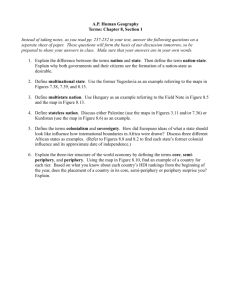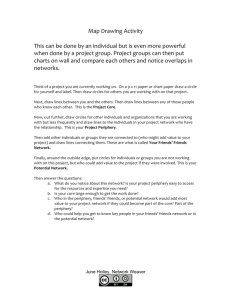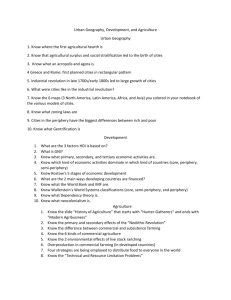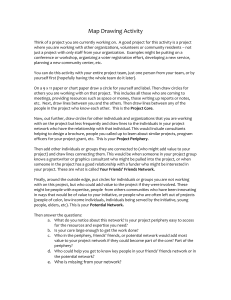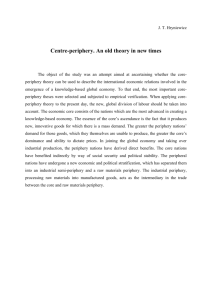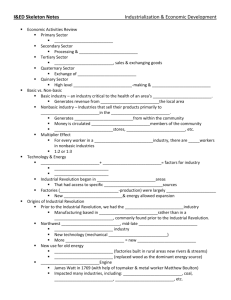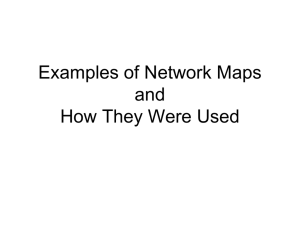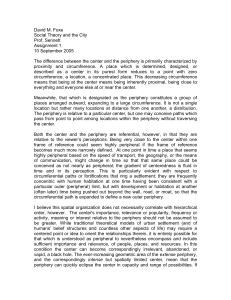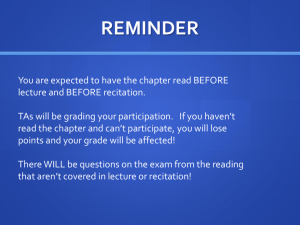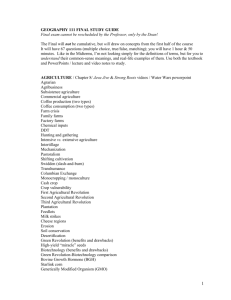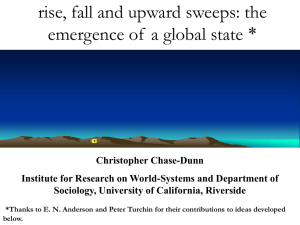Chapter 9: Global Inequality Part 2 III. Why worry about the rest of
advertisement
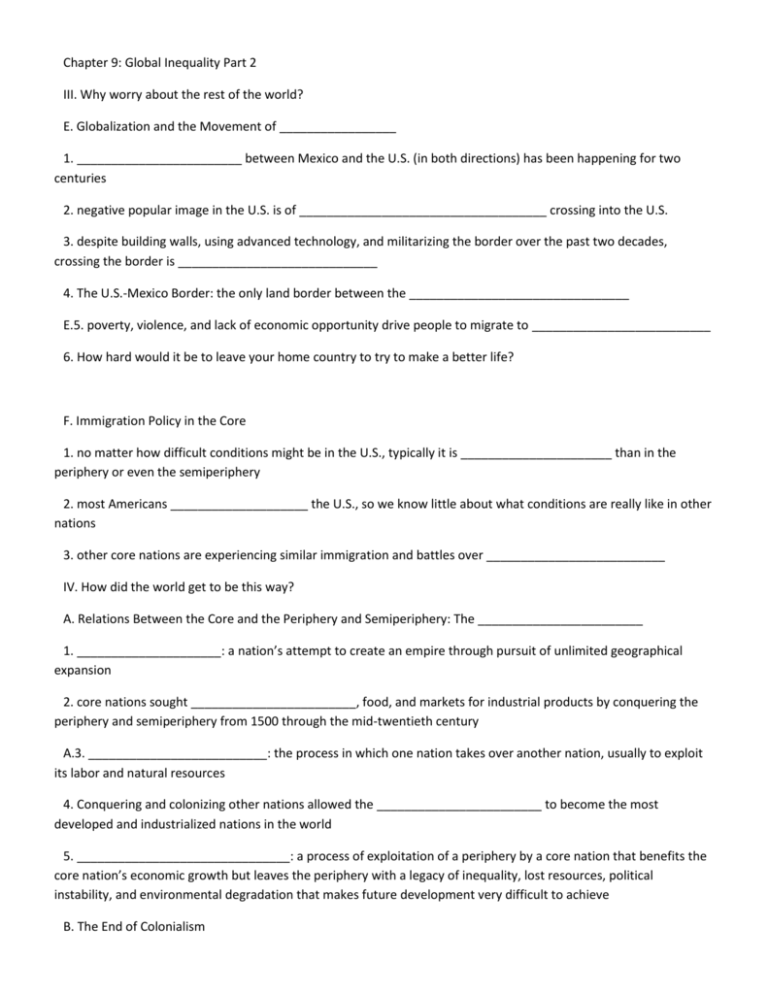
Chapter 9: Global Inequality Part 2 III. Why worry about the rest of the world? E. Globalization and the Movement of _________________ 1. ________________________ between Mexico and the U.S. (in both directions) has been happening for two centuries 2. negative popular image in the U.S. is of ____________________________________ crossing into the U.S. 3. despite building walls, using advanced technology, and militarizing the border over the past two decades, crossing the border is _____________________________ 4. The U.S.-Mexico Border: the only land border between the ________________________________ E.5. poverty, violence, and lack of economic opportunity drive people to migrate to __________________________ 6. How hard would it be to leave your home country to try to make a better life? F. Immigration Policy in the Core 1. no matter how difficult conditions might be in the U.S., typically it is ______________________ than in the periphery or even the semiperiphery 2. most Americans ____________________ the U.S., so we know little about what conditions are really like in other nations 3. other core nations are experiencing similar immigration and battles over __________________________ IV. How did the world get to be this way? A. Relations Between the Core and the Periphery and Semiperiphery: The ________________________ 1. _____________________: a nation’s attempt to create an empire through pursuit of unlimited geographical expansion 2. core nations sought ________________________, food, and markets for industrial products by conquering the periphery and semiperiphery from 1500 through the mid-twentieth century A.3. __________________________: the process in which one nation takes over another nation, usually to exploit its labor and natural resources 4. Conquering and colonizing other nations allowed the ________________________ to become the most developed and industrialized nations in the world 5. _______________________________: a process of exploitation of a periphery by a core nation that benefits the core nation’s economic growth but leaves the periphery with a legacy of inequality, lost resources, political instability, and environmental degradation that makes future development very difficult to achieve B. The End of Colonialism 1. After World War II, most peripheral and semiperipheral nations became ______________________ 2. However, core nations remain the wealthiest and most powerful and most peripheral nations remain _______ 3. Some nations able to move up via ___________________________________: poor countries can still develop economically but only in ways shaped by their reliance on the wealthier countries C. How does the core stay wealthy and only a few other countries move up in the world system? 1. __________________________: the economic and political dominance of peripheral and semiperipheral nations by the core through control over capital, technologies, and the markets and prices for products 2. One mechanism of neocolonialism is ______________________________________: companies based in the core that operate in many countries around the world C.3. Other _______________________ of Neocolonialism: a. _____________________________: bank funded mainly by core nations to promote development and improved quality of life in poor nations; many loans used to pay core TNCs to build dams, factories and other large projects that often prove to be money-losers b. International _______________________ (IMF): agency funded by core nations to loan money to bankrupt poor nations’ governments, in return for adopting policies that favor TNC investment and foreign trade and reducing subsidies to the poor C.3.c. General Agreement on Tariffs and Trade (GATT)/ World Trade Organization (WTO): international __________ and agencies to administer them that have gradually expanded foreign trade and TNC investment around the world since the 1950s 4. all of these mechanisms of neocolonialism reduce governments’ ability to _________________________ TNCs (including allowing TNCs to close factories in the core and open new factories in peripheral nations with lower wages and little environmental protection) D. ____________________________ to the Negative Impacts of Globalization 1. ______________________________ Organizations (NGOs): citizens’ groups formed to promote environmental protection, human rights, democracy and other goals; many oppose IMF, WB and TNC economic and political power 2. Governments opposed to _____________________________: the economic belief that free-market forces, achieved by minimizing government restrictions on business, provide the only route to economic growth 3. Governments seeking to gain _______________________ for themselves in the world system: BRICs: Brazil, Russia, India, China E. So why do peripheral and semiperipheral nations put up with this situation? 1. because these investments by transnational corporations, foreign trade, and loans are the most important sources of ___________________________ in these nations 2. few __________________________ are available because of these international agreements and the power of core nations and TNCs V. What’s Next for the World System? A. __________________________ will continue 1. trade and investment across international boundaries by transnational corporations will continue to __________ 2. all economies and societies are increasingly tied to and in ____________________ with one another B. Rapid Growth of ______________ in Periphery and Semiperiphery 1. ever larger share of the world’s _________________________ living in these cities 2. ___________________________________: a rate of urban growth that outstrips economic growth, leading to widespread unemployment and overburdened public services 3. despite problems, misery is _______________________; governments provide food, electricity, and transportation subsidies to urban residents while wealthier residents provide opportunities for service employment (store clerks, domestic servants) C. Larger Numbers of _____________________________________ in the Periphery 1. allowing further movement of factories and their jobs from the _______________ to the periphery D. Rise of ____________________ 1. rapid __________________________ since opening the economy to foreign trade and investment in the 1980s 2. by some measures, China’s economy is already the ____________________________ 3. China’s growing economic and military power threatens its neighbors and challenges U.S. ________________ E. Need to Prepare for Life in a _____________________________ 1. studying foreign ________________________ 2. ___________________ other countries, other cultures, international relations 3. _______________________________ programs 4. plan _______________________ with recognition of increased global competition and interconnectedness
